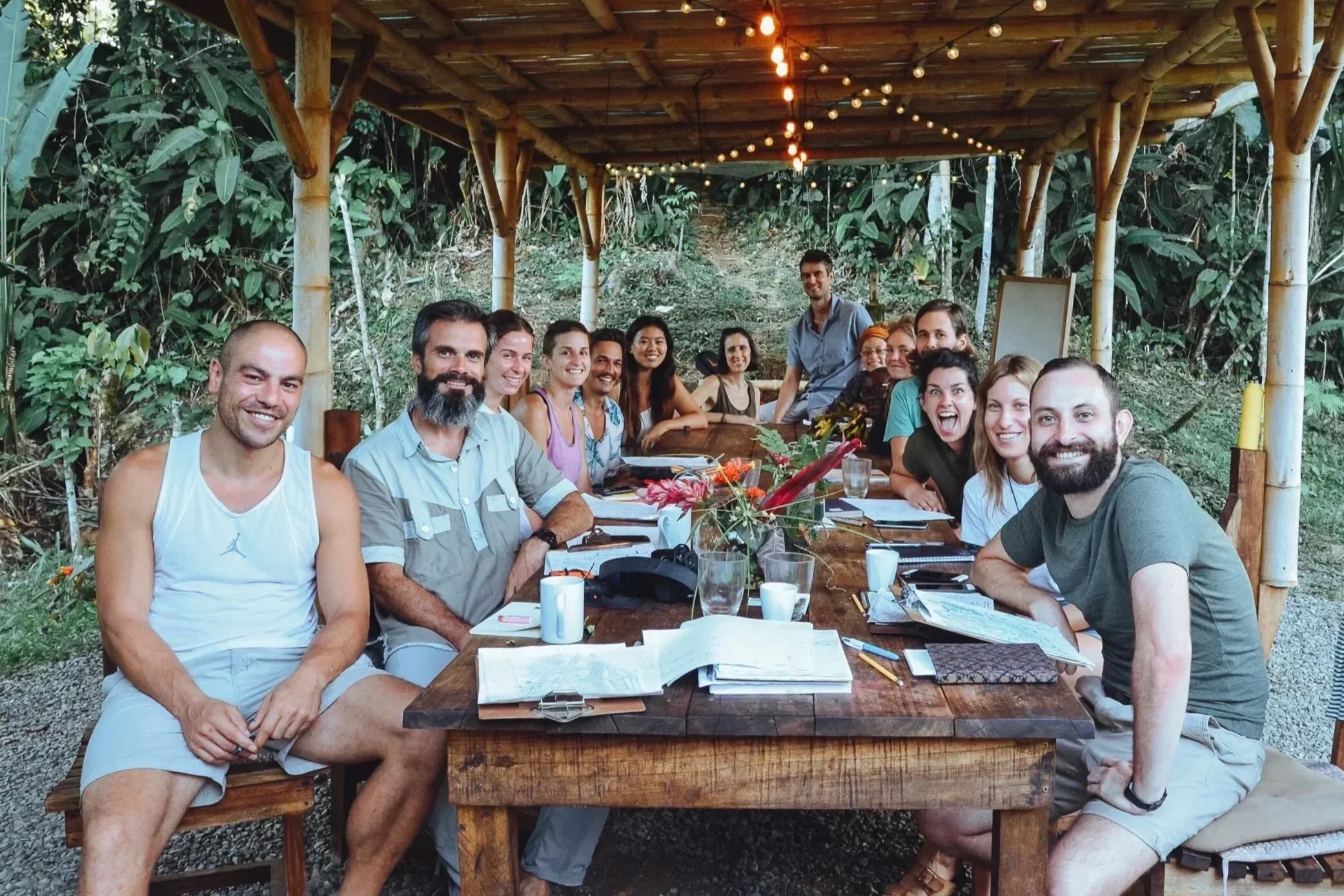Permaculture Design Course: Learn to Build a Sustainable Life Anywhere in the World
Inside Finca Tierra: A global classroom for regenerative living
From the cold winters of Canada to Ethiopia’s drylands, Brazil’s rainforests, and the desert heat of Dubai, students from more than forty countries travel each year to our small corner of the Caribbean coast of Costa Rica to study permaculture design and explore what it truly means to live self-sufficiently.
They arrive to design regenerative farms, homesteads, wellness centers, yoga retreats, and eco-villages; learning principles that can be applied in any climate, to any lifestyle, anywhere on Earth.
What began as our family homestead, tucked deep in the jungle, has grown into an international education center and living laboratory for sustainable living. Here, every system, from compost to solar energy, has been built to serve both people and the planet.
At Finca Tierra, learning doesn’t happen only in a classroom. It happens in the gardens, in the kitchen, in the forest, and around the table.
Students don’t just hear about sustainability, they live inside it!
What is a Permaculture Design Course?
A Permaculture Design Course (PDC) is much more than a class. It’s a comprehensive introduction to the science of ecological design, understanding how natural systems function and how to apply their principles to human life.
At Finca Tierra, we teach permaculture as a living system:
closed nutrient loops
zero waste
designs that capture energy, build fertility, and sustain life
I often describe it as “a peaceful revolution you can practice at home.”
Once you see how ecosystems self-regulate, you begin to understand that abundance is a design choice, and that sustainability is, at its core, a question of ethics and imagination.
Learning through real systems
Our Permaculture Design Course combines the internationally recognized 72-hour curriculum with the depth of fifteen years of practical, tropical experience.
Over the course of two weeks, students explore how nature and people can coexist in balance. Mornings are spent outdoors: composting, grafting trees, planting food forests, and regenerating soil. Afternoons unfold in the open-air classroom, where students sketch maps, study water systems, and discuss how ecology, economy, and community are interdependent.
Each group completes a capstone design project, planning a ½-hectare homestead on the farm. Some envision family farms, while others design eco-lodges, yoga centers, or community spaces. In every case, they leave understanding that living sustainably is not about limits, it’s about better design.
Education by immersion
Life at Finca Tierra moves at the rhythm of the tropics. The mornings begin with the sounds of birdsong and a delicious farm-to-table breakfast. Students gather in the gardens to plant, prune, or harvest. Lunches are shared beneath bamboo roofs, prepared from the very crops planted by previous students.
The afternoons are filled with design work and reflection, and the evenings unfold into community, marked by shared meals, stories, and music.
Many students tell us these two weeks changed the way they see the world: how they eat, how they design, how they live. Because here, every system around you — water, energy, compost, food, shelter — becomes part of your learning.
You don’t just learn permaculture. You experience what it feels like when a landscape takes care of you in return.
How it all began
When Ian and I first came to this land in 2008, it was an abandoned cattle pasture, characterized by compacted soil, eroded streams, and a lack of trees. We took down the barbed wire and began planting. We wanted to prove that degraded land could heal, let wildlife thrive, and that it could feed us abundantly.
We experimented with hundreds of tropical crops, learning which plants produced the most nutrition with the least effort. We pressed coconut oil, milled flour, fermented chocolate, evaporated sugar, roasted coffee, and harvested our own sea salt. We designed systems that recycled everything: food, water, energy, and waste.
And slowly, the land responded.
We realized that true sustainability emerges when human needs and ecological regeneration are aligned as a single goal.
That realization became the foundation of Finca Tierra.
What started as a small homestead evolved into an education center, teaching through a living example of what is possible when humans collaborate with nature instead of extracting from it.
Years later, during the pandemic, our local community began to struggle. People had land, but many didn’t know how to regenerate compacted clay soils or grow a complete diet for their families. In response to that need, we developed the Tropical Online Permaculture Design Course. It began as a tool to support our country, Costa Rica, and has now become a resource for people across the tropics worldwide.
The online course was developed as a step-by-step program for designing regenerative projects in tropical climates, with video lessons, written modules, design templates, and crop-area charts that guide students through planning a tropical homestead or community project, from anywhere in the world.
Alumni community
PDC fieldtrip to learn indigenous cosmovision, natural building & ethnobotany with Don Joni.
Every student arrives with a story. Some are farmers, while others are architects or economists; others are young, seeking purpose, and families or travelers simply looking for freedom from modern systems and a healthy lifestyle. What unites them is a desire to reconnect with the natural world and to create systems that benefit both ourselves and the planet.
Students leave with more than a Certificate. They leave with a new way of seeing: that design can heal, that food can be medicine, and that a sustainable life is something everyone can create.
“Seeing systems that actually work in real life made everything click” - Miguel, Mexico. “I left with a plan, and the confidence to build it”- Amelia, Australia.
That, to us, is the true purpose of permaculture design: not only to grow food, but to create a free, healthy and self sufficient lifestyle.
Learn more
On-Site 2-Week Immersion — Costa Rica (72-hour Certificate) →
Wake up in a bamboo cabin surrounded by food forests & jungle in Costa Rica. Learn through real-world permaculture systems in the mornings and design regenerative landscapes in the afternoons — the 72-hour Permaculture Design Course (PDC) is all-inclusive, with accommodations, farm-to-table meals, and a field trip exploring indigenous cosmovision.
Plant · Harvest · Cook Retreat — Costa Rica →
A week of cooking, gardening, and slow tropical living in the rainforest. Stay in a private cabin, enjoy farm-to-table meals, and learn simple regenerative skills with us at Finca Tierra.
7 days · 6 nights · Private cabin · Farm-to-table meals · Garden & cooking sessions
Online Tropical Permaculture Design Course →
A complete step-by-step program with video lessons, written modules, design templates, and crop/area charts. Designed for tropical climates, the course allows students to study from anywhere and develop a homestead or regenerative project at their own pace.
FAQ — Common questions
-
Yes. The principles apply to every climate. You’ll learn design strategies for humid tropics, drylands, and temperate zones. The Online course, however, is specific to the Tropics.
-
No. The course welcomes beginners, homesteaders, farmers, and designers of all levels.
-
The online course focuses on tropical permaculture—teaching how to design and grow food systems for tropical climates through videos, templates, and practical tools.
The on-site course follows the international Permaculture Design Certificate curriculum and adds two weeks of immersive, hands-on learning in Costa Rica. You will be able to design, build, teach and certify others. -
Yes—your capstone design is a 1-acre/½-hectare homestead plan you present at the end. Online students create a plan too, -
Yes. Tuition is All-inclusive: private or shared bamboo cabin, three farm-to-table meals daily (with vegan and gluten-free options), field trip, 72-hour course, and international certificate.
-
The On-site course is taught in English. Students attend from over 40 countries, creating a truly international learning environment. The Online tropical permaculture course is in english. It will be in spanish and other languages very soon. Stay tuned!
-
Visit our Permaculture Design Course page to see upcoming dates and registration details.
Related reading
Tropical Food Forest Design: Best Trees & Support Species for Abundance
Tropical Vegetable Garden: How to Grow Abundantly in the Tropics
Permaculture Design Course: Learn to Build a Sustainable Life Anywhere
About the authors
Ian Macaulay is an artist, tropical permaculture designer, and educator specializing in food forests, regenerative homesteads, and tropical agroforestry.
Ana Gaspar A. is a Costa Rican lawyer and sustainability advocate passionate about indigenous cosmovision, bioregional community organisation, food sovereignty, and ecolegality.
Together, they founded Finca Tierra Permaculture Education Center, where they live off the grid, teach internationally certified Permaculture Design Courses, and develop replicable models for self-sufficient living in the tropics.
fincatierra@gmail.com










